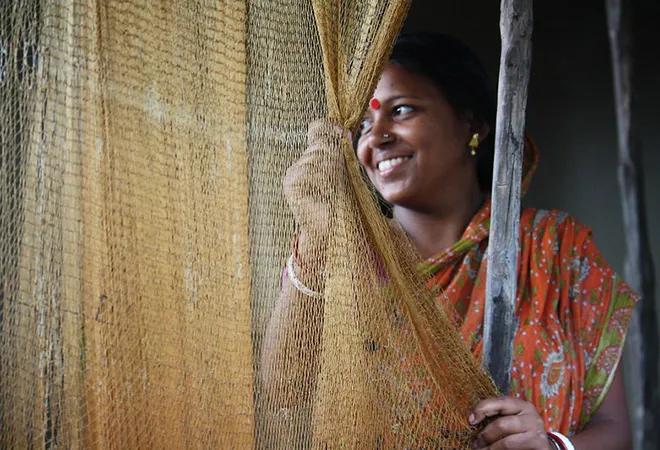 This article is part of the series — Catalysing Change: Women-led Development in the Decade of Action.
This article is part of the series — Catalysing Change: Women-led Development in the Decade of Action.
Women have borne the brunt of the pandemic’s disruption
2020 upturned the world and the state of women has been shattered. Research by Azim Premji University shows that Indian women were significantly more likely than men to have lost their jobs during the pandemic. Female casual workers and female entrepreneurs have been particularly vulnerable. Between November 2019 and November 2020, the urban Indian female work force contracted by 27 percent (compared to 3 percent for men). Women had to suddenly become teachers as well as parents, homemakers and caregivers. Some had to drop out of work as it was impossible to manage the more than 30 percent increase in unpaid work by 30 percent.
Female labour force participation had in any case been under pressure… for years!
India has made much progress on many fronts across the years. Female labour force participation is among the few development indicators that have stubbornly refused to move in the right direction. India has the lowest female labour force participation in South Asia. On the Global Gender Gap Index by the World Economic Forum (WEF), India has fallen 39 places since 2006 and now ranks 112 of 153 countries, largely due to the economic gender gap. There are multiple and complex reasons for these trends, but the abysmal absolute numbers serve as a clarion call on both the potential and urgency of action.
Getting it right will be hard, but the potential is revolutionary
Increasing economic participation of women will require priority, resourcing and effort across education, skilling, income generation and social norm changes. It is important to appreciate that it will not be easy to shrug off the weight of generations of gender discrimination. It is sobering to acknowledge that women’s issues are unlikely to naturally rise to the top of government priorities given the pandemic of our generation. It is, however, crucial that we do everything possible to get it right for women, because the economic and social potential is massive and investing in women is likely to deliver the highest returns from all the post pandemic recovery spending and initiatives — and will build the societal resilience to handle future shocks.
McKinsey & Company estimates taking action now to advance workforce gender equality could add US$ 770 billion of added GDP by 2025. The low base in India — with only ~10 percent of Indian women of working age in employment (compared to ~65-70 percent of men) — points to the potential.
So, what is the reimagination that will be needed for India to realise this opportunity?
Priority, policy and programming are going be needed. We need to ensure basics and also foster innovation.
Girls and young women need both life and vocational skills for the jobs of the future
The Indian government has a longstanding commitment to gender equality. One critical aspect of the government’s commitment is to enable girls (and women) to build 21st century skills — which are those life skills needed for confident participation in the world they are growing up in.
In every skilling and livelihoods effort, we need to break out of stereotypes of what jobs are “suited” for women. That is an idea whose time has long since passed. The more useful factors should be what are the jobs of the next 50 years, or which jobs can be done anywhere rather than only in urban concentrations, or what can be done through flexible hours. All of us need to learn from gig economies.
Addressing deep-rooted gender issues cannot be the sole responsibility of one Ministry
Given the massive potential of female education and incomes on health, education, nutrition, prosperity, justice and climate change, gender should not be limited to one ministry but mainstreamed across government, legislature, administration and judiciary. The default should be a gender lens that is applied literally to every law, policy document, judgement, etc.
Employment, skilling, credit, social protection, education and care policies need to be designed with a clear objective of improving them for women and girls. For instance, Indian women do 10 times more unpaid care work than Indian men. Policies that increase the access and affordability of domestic care services will reduce the burden on women and enable some of them to return to or even start working.
We need to force the system to think and act ‘gender-just’ by ensuring that gender disaggregated data is collected, reported and used for decision making — especially in the blind spots we know of like social protection, financial inclusion and digital access schemes of the government. Illustratively, everything from MNREGA to NABARD’s Credit Guarantee Scheme should target, report and adapt for women.
Think “outcomes” rather than count “inputs” or “activities” — as this will fuel the urgency, innovation and data-driven decisions to make real change
Driven partially by the complexity of the challenge, much of the ecosystem is caught up in tracking activities. Indicators with broad visions often times have the value of serving as organising principles for the work. One that holds great promise is “percentage of women which stay in employment at or above the national average salary”; this addresses both retention and gender pay discrimination.
Most employment programs have failed in long term job retention, with 90 percent of women dropping out in the first three months. Incentivising these goals through results-based financing mechanisms, such as impact bonds, can be used to focus and deliver on these social outcomes. Such approaches also drive accountability and fuel both superior performance and innovation.
We need a giant tent to welcome in new ideas, new monies and new players
There is so much that can be done by so many — and every one of us should help to nurture this. Every single aspect of life has a gender dimension — and the beauty is that there is almost always, clear evidence of the value of progressive gender action. Companies with more gender diversity in leadership roles and at management levels, for example, have higher profits and create more shareholder value. The “inclusion dividend” is being established as a real and significant business advantage by progressive companies who advance inclusion and diversity.
Prioritise girls and women. Keep them central to both the immediate post-pandemic recovery efforts but stay focused on them longer term. This strategic logic is strong and the benefits are wide and deep.
The views expressed above belong to the author(s). ORF research and analyses now available on Telegram! Click here to access our curated content — blogs, longforms and interviews.



 This article is part of the series —
This article is part of the series —  PREV
PREV



